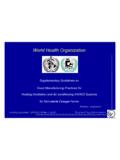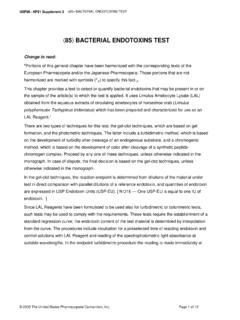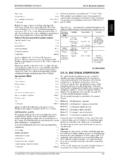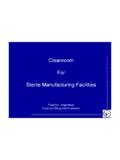Transcription of PFR Validation guide - gmpua.com
1 Validation guide USTR 2114(2). Validation guide for Pall Emflon PFR. Filter Cartridges CONTENTS. Part I. Overview 4. 1. Introduction 4. 2. Summary of Conclusions 4. Part II. Studies on Removal Efficiency 6. 1. Microbial Validation using Brevundimonas diminuta Liquid Challenge Tests 6. Introduction 6. Summary of methods 8. Results 10. Conclusions 13. Microbial Validation of other styles of Emflon PFR filters 15. 2. Aerosol Bacterial Retention Tests using Brevundimonas diminuta 22. Introduction 22. Summary of methods 22. Results 23. Conclusions 24. 3. Long-Term Aerosol Microbial Challenge Tests 25. Introduction 25. Summary of methods 25. Results 27. Conclusions 28. 4. Bacteriophage and Spore Aerosol Challenge Tests 29. Introduction 29. Summary of methods 29. Results 30. Conclusions 31. 5. Sodium Chloride Aerosol Challenge Testing 32. Introduction 32. Summary of methods 32. Results 33. Conclusions 33. Part III. Validation of Physical Characteristics 34.
2 1. Resistance to Steam Sterilization 34. Introduction 34. Summary of methods 34. Results 35. Conclusions 37. 2. Resistance to Vaporized Hydrogen Peroxide 38. Introduction 38. Summary of methods 38. Results 39. Conclusions 39. 3. Resistance to Hot Air 40. Introduction 40. Summary of methods 40. Results 40. Conclusions 42. 4. Air Flow/Differential Pressure Characteristics 43. Introduction 43. Summary of methods 43. Results 43. Conclusions 44. 5. Water Flow/Differential Pressure Measurements 45. Introduction 45. Summary of methods 45. Results 45. Conclusions 45. Part IV. Extractables and Biological Safety Testing 46. 1. Extractables Testing of Emflon PFR Filters 46. Introduction 46. Summary of methods 46. Results 47. Conclusions 48. 2. Biological Safety Tests on Components of Emflon PFR Filter Cartridges 48. Introduction 48. Summary of methods 49. Results 49. Conclusions 49. Appendix 1 50. 3. Part I. Overview 1. Introduction This report contains Validation data applicable to Pall microbially-rated Emflon PFR filter cartridges.
3 Emflon PFR filters contain proprietary PTFE filter membrane and they are designed for sterilizing air and gas applications. Emflon PFR filters may also be considered in some liquid applications. This report is designed to assist the filter user in meeting the Validation requirements of regulatory authorities within the pharmaceutical industry. 2. Summary of Conclusions Part II. Studies on Removal Efficiency Emflon PFR filters were tested using liquid challenge tests using Brevundimonas diminuta (ATCC 19146), in accordance with the FDA guidelines on Sterile Products produced by Aseptic Processing (1987). These tests demonstrated that Emflon PFR filters retain 107 Brevundimonas diminuta per cm2 in liquid. Forward Flow and water intrusion integrity tests were shown to be suitable non-destructive integrity tests for Emflon PFR filters, and test parameters correlated to liquid bacterial challenge tests have been set. Various aerosol microbial challenge tests were also performed on typical production filters.
4 These tests demonstrated that Emflon PFR filters retain high levels of aerosol bacteria, bacteriophage, spores and sodium chloride particles. A summary of the aerosol challenge data is shown below: Aerosol Challenge Direction of Flow During Result Suspension Challenge Test Brevundimonas diminuta Forward ( out to in') TR* > x 109. (ATCC 19146). Brevundimonas diminuta Reverse ( in to out') TR* > x 108. (ATCC 19146). Brevundimonas diminuta Forward 30 day test TR* > x 1010. (ATCC 19146). Bacteriophage PP7 Forward TR* > x 1011. Bacteriophage MS-2 Forward TR* > x 1011. Bacillus subtilis Forward TR* > x 1010. Var niger spores Bacillus subtilis Forward 30 day test TR > x 1010. Var niger spores Sodium chloride Forward Data supports a gas rating of m * TR Minimum titer reduction observed during testing 4. Part III. Validation of Physical Characteristics Resistance to Steam Sterilization Emflon PFR filter cartridges have been demonstrated to retain integrity after repeated steam in place cycles, under the conditions listed below: Test Temperature Steam Flow Cycle Time Differential Total Steam Direction Pressure Exposure A 142 C (288 F) Forward 11 hours < 300 mbar ( psid) 176 hours B 142 C (288 F) Forward 1 hour < 300 mbar ( psid) 165 hours C 125 C (257 F) Forward 1 hour 1000 mbar ( psid) 30 hours D 125 C (257 F) Reverse 1 hour 500 mbar ( psid) 40 hours Resistance to Hydrogen Peroxide Vapor Emflon PFR filters demonstrated excellent resistance to vaporized hydrogen peroxide and may therefore be considered for applications where sterilization by vaporized hydrogen peroxide is required.
5 Resistance to Hot Air The data presented demonstrate that Emflon PFR filters withstand exposure to air at elevated temperatures. Based on cyclic exposure to steam and hot air, the results indicate that Emflon PFR. filters will retain integrity following exposure of well over one year at 60 C (140 F). Air Flow/Differential Pressure and Water Flow/Differential Pressure Measurements The relationship between air flow and differential pressure was investigated using typical production filters at different flow rates and inlet pressures. Water flow rates at set differential pressures using alcohol-wetted filters were also determined. The data obtained during these studies can be used to form the basis of sizing calculations for the use of Emflon PFR in gas and liquid service. Part IV. Extractables and Biological Safety Testing The gravimetric residue after flushing autoclaved filters in a number of extracting fluids was determined using typical production filters.
6 A summary of the results obtained is shown below: Extraction Fluid Residue per 25 cm (10") Filter Deionized water 1 3 mg Isopropyl alcohol 15 17 mg Ethanol 34 59 mg Diethyl ether 382 559 mg Emflon PFR filter cartridges were found to meet the requirements of the USP for Class VI (121 C) Plastics. 5. Part II. Studies on Removal Efficiency 1. Microbial Validation using Brevundimonas diminuta Liquid Challenge Tests Introduction The FDA guidelines on Sterile Products Produced by Aseptic Processing (1987) state, A sterilizing filter is one which, when challenged with the micro-organism Pseudomonas diminuta (P. diminuta), at a minimum concentration of 107 organisms per cm2 of filter surface, will produce a sterile effluent'. In order to meet the requirements of this guideline, liquid challenge tests using Brevundimonas (Pseudomonas). diminuta (ATCC 19146) were performed with Emflon PFR filter cartridges using a minimum of 1 x 107. colony forming units (CFU)/cm2 of effective filtration area.
7 The correlation between microbial retention and a non-destructive integrity test is also an important aspect of the Validation of sterilizing grade filters. The FDA guideline further states, After a filtration process is properly validated for a given product, process and filter, it is important to assure that identical filter replacements (membrane or cartridge) used in production runs will perform in the same manner. One way of achieving this is to correlate filter performance data with filter integrity testing data'. The integrity tests used during this Validation study were the Forward Flow and water intrusion tests. The Forward Flow Integrity Test In the Forward Flow test, a filter is wetted with a suitable test liquid and a pre-determined gas pressure is applied to the upstream side of the filter assembly. After a stabilization period, the gas flow through the wetted membrane can be measured manually on the downstream side or on the upstream side, using sensitive flow measurement equipment such as the Palltronic Flowstar or Palltronic Aquawit filter integrity test devices, as shown in figure II-1.
8 Figure II-1 The Forward Flow Integrity Test Palltronic Flowstar test device P. Outlet open to atmosphere Regulated compressed Upstream isolated gas supply 6. The Water Intrusion Integrity Test The water intrusion test is performed on a dry filter. The upstream side of the filter assembly is filled with water and a pre-determined gas pressure is applied. The resulting water flow through the membrane can be measured directly on the upstream side using sensitive direct flow measurement equipment such as the Palltronic Flowstar or Palltronic Aquawit filter integrity test devices (as shown in Figure 11-2). Figure II-2 The Water Intrusion Test Air Filter installed in water filled housing Palltronic integrity test Water device The aims of this series of tests were to: Determine the microbial removal efficiency of Emflon PFR filters in liquid challenge tests using Brevundimonas diminuta (ATCC 19146). Correlate non-destructive Forward Flow and water intrusion integrity tests with destructive challenge tests Determine integrity test parameters 7.
9 Summary of Methods Install filter in housing . Perform water intrusion test . Flush with wetting liquid . Perform Forward Flow test . Flush with water . Steam sterilize assembly . Perform microbial challenge tests and determine titer reduction . Flush with wetting liquid . Perform Forward Flow test . Flush with water . Dry filter . Perform water intrusion test Emflon PFR filters (part number AB1 PFR7 PVH4) with a range of Forward Flow and water intrusion values were selected from manufacturing lots and subjected to microbial challenge tests using an aqueous suspension of Brevundimonas diminuta (ATCC 19146). The filter sample was installed in a housing and tested for integrity by the water intrusion and/or Forward Flow method, prior to being autoclaved at 121 C (250 F) for 60 minutes. The filter assembly was then aseptically connected to a pre-sterilized challenge apparatus, shown schematically in Figure II-3. Figure II-3 Microbial Challenge Apparatus Bacterial P.
10 Injection port Sterile Challenge filter filtered water Analysis membrane filter Steam Drain 8. An aqueous suspension of B. diminuta was passed through the filter to achieve a challenge level of > 1 x 107 colony forming units (CFU) per cm2 of effective filtration area. A total challenge per filter of > 1 x 1011 CFU was achieved in all tests. On completion of the challenge, a second water intrusion and/or Forward Flow test was performed. During the challenge test, the entire filter effluent was passed through a m-rated analysis disc on the downstream side of the test filter assembly. The filter disc was incubated on agar and, following incubation, the disc was examined to determine if bacteria had passed through the test filter during the challenge. The titer reduction (TR) for each filter was determined as follows: TR = Total number of organisms influent to the filter Number of colonies recorded on the downstream analysis disc When no colonies were detected downstream, the titer reduction was expressed as: >Total number of organisms influent to the filter ( > 1 x 1011).









